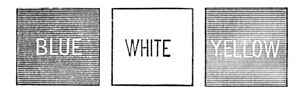approaches green; the light is white, with a slight tint of pink (Fig 4). Now, in this experiment, I have obtained our white light by the actual mixture on the screen of yellow and blue light, furnished by the same two glasses which, a little while ago, when superimposed,
Fig. 3.

gave us green light. The apparatus is so contrived that the glasses send toward the screen yellow and blue beams of light, but, before traveling far from the lantern, these beams are caught by this large crystal of cale-spar, and each, as you see, is duplicated. Let us pursue this matter a little further, and, to facilitate our judgment of the tints, I throw on the screen, near the colored squares, a circle of unaltered white light, for comparison. Perhaps we have failed to produce green light from the circumstance that our yellow squares were too bright; with a simple contrivance I can diminish their luminosity without altering their tint, and the rate of diminution you can easily watch in
Fig. 4.

the uncombined yellow square. This apparatus is now acting, but though under its influence the tint of the central square changes, passing from white by a series of gradations into blue, you see that it manifests no tendency to become green. Restoring the yellow squares to their original brightness, in the same way I gradually cut down the brightness of the blue squares, and yet fail to generate any hue approaching green.
A result like this ought to shake, if not entirely destroy, our confidence in the old theory, but Helmholtz has pursued the investigation still further, and has proved, in addition, that the union of the pure yel-
